Frogs are near the bottom of many food chains. Small, and mostly defenseless, they are the favourite snack of many birds, fish, and even reptiles. In order to keep themselves off the menu as much as possible, many frogs have developed some ingenious methods for keeping themselves safe, including camouflage, exuding toxins and hiding.
Much of what we admire in frogs is down to their need to stay safe, from their interesting patterns to their vibrant colours. Understanding the ways frogs defend themselves can also help us understand their weak points, and where they might be at risk from new human-caused dangers.
Also read: Can Butterflies Sting? How do They Protect Themselves?
Physical Adaptations
Camouflage
Camouflage is a common technique employed within nature, both by predators and prey. For predators it can help them go unseen so as to give them the advantage over their prey, for prey it can keep them hidden from those that mean to harm them.
Frogs employ camouflage for both of these reasons. Many frogs are ambush hunters, remaining still and unseen so they can grab their prey when least expected. They also use camouflage very effectively to hide away from the many predators that might choose to eat them.
Camouflage comes in many different forms. It can mean that the colour of an animal is muted or blends into its surroundings, that the patterns on its body help to make its outline less obvious, or that the shape and texture of its body helps hide it away.
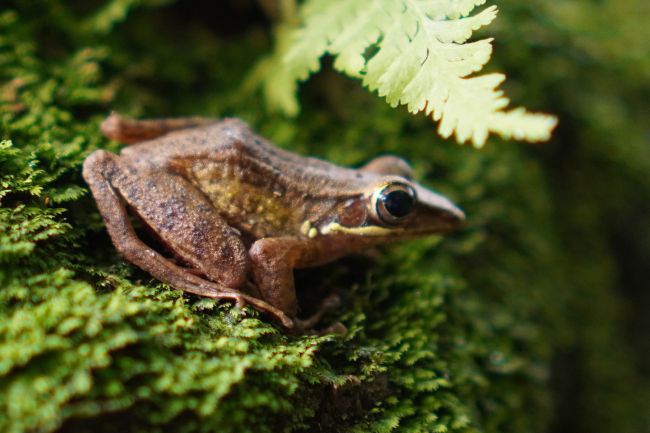
Sometimes an animal’s camouflage may not seem very effective to human eyes. For example, the orange and black strips of a tiger seem to stand out to us against any green backdrop. However, often an animal’s vision will be different from our own, with many animals not seeing certain colour ranges, or viewing the world in black and white. For these prey animals the tiger completely disappears.
Frogs use a fantastic array of camouflaging techniques. The most common is to be a shade of brown or green. As frogs spend much of their time on the ground, or in vegetation, these are the perfect colours to help them blend in.
As well as colour, many frogs have patterns across their skin, such as a mottled or blocky effects to help them disappear. Large blocks of colour can often make animals stand out against a more complex background.
Finally, they also use their body shape and texture to hide. Some frogs are slightly flattened or have bumpy skin or pointed protrusions. This can help them look like parts of the plants or soil they are resting on.
| Defense Mechanism | Description | Notable Frog Species |
|---|---|---|
| Camouflage | Coloration and patterns to blend into environment | Green Tree Frog, Mossy Frog |
| Poisonous Skin | Secretes toxins to deter predators | Poison Dart Frogs |
| Mimicry | Resembling toxic or dangerous species | Malaysian Horned Frog |
| Inflation | Inflating body to appear larger and unpalatable | Tomato Frog |
Also read: Evolution of Frog Skin: Do Frogs Have Scales?
Examples of frogs that use camouflage
Glass frogs
Glass frogs are particularly stunning when it comes to frog camouflage. This is because their body is partially see-through. This means you can see the organs inside them pumping away. This might not seem particularly helpful, but it can be useful to make them less visible to predators, even those beneath them who might see their outline against a leaf.
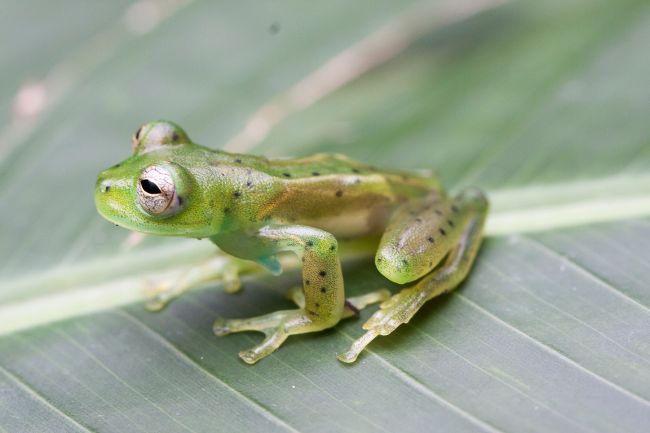
Vietnamese mossy frog
The Vietnamese mossy frog is truly a master of disguise. With a mottled green and black appearance it already blends in pretty well to its surroundings, but the final flourish is the texture of its skin, which is incredibly bumpy. Even knowing it’s a frog you can look at this creature and think it might be a lump of moss.
Red-eyed tree frog
The red-eyed tree frog is perhaps one of the most famous frogs in the world, well known for its green body and bright red eyes. While it may be striking to look at, it is still able to hide itself away, by its ability to flatten itself against the surface of a leaf or the trunk of a tree. With its legs tucked beneath it and its body flattened, it’s surprisingly easy to miss. Another marvel are its eyelids, which are patterned in a kind of skeletal-leaf pattern, which helps hide its brilliant eyes when it’s at rest.
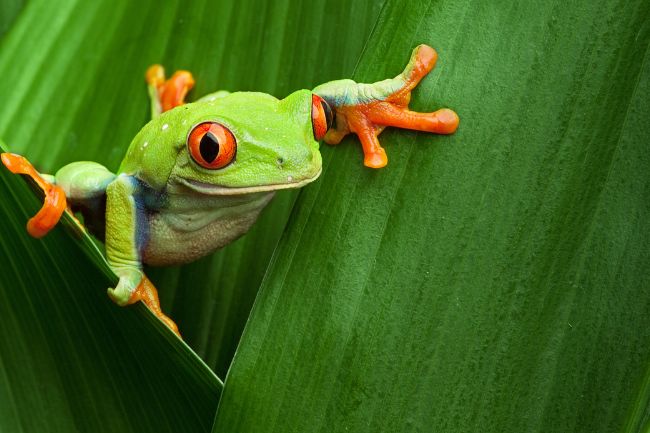
Also read: Frog Eyes Unveiled: Do Frogs Blink?
Poisonous Skin
When it comes to self-defense, frogs don’t have much to offer. Mostly they lack the claws and large teeth that might help them fight off a larger predator. The one trick they do have up their sleeves is poison.
Many frog species exude toxic substances through glands in their skin. These toxins then coat their skin, meaning that if a predator tries to eat them they get a nasty surprise. As the toxins often taste unpleasant a frog might be lucky enough to be spat straight out again, however, even if the frog does get eaten it has a way to make this work in its favour.
Warning colouration is the opposite side of the coin to camouflage. Unlike camouflage they make an animal more visible, not less. These are usually bright colours, such as reds, yellows or oranges, which make the animal stand out. They may also have contrasting colours to create striking patterns such as strips.
Warning colouration lets an animal know that the creature it is considering eating is poisonous. If this animal doesn’t read the signs and eats the creature anyway it will get sick and then learn not to eat another creature that looks like this.
Also read: Are Caterpillars Poisonous? Are they Dangerous? (Explained)
Effects of the Toxins on Predators
There are lots of different compounds that poisonous frogs use to make themselves distasteful. Most come from the food they eat, and they will accumulate these toxins in their bodies for their own use. Poisons can range from something that might merely make their attacker feed sick, to those that can kill ten adult humans.
For most animals the poisons in the frog’s skin will taste immediately unpleasant, therefore making them spit the frog out. To others the toxins may lead to vomiting. Some of the more harmful toxins can result in organ failure or nerve damage.
Examples of Poisonous Frogs
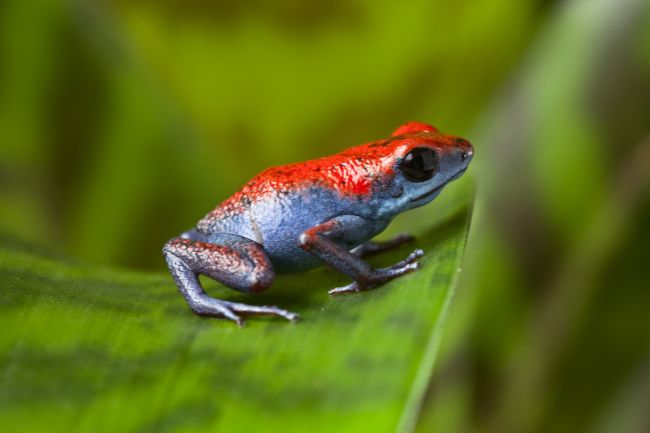
The most famous of the poisonous frogs are naturally the poison dart frogs. These miniature tropical species are well known for their bright colours and striking patterns. It’s this that has made them a favourite of zoos and pet shops. Luckily, they only acquire their toxins if they are fed the toxic foods they eat in the wild, meaning they can be reared perfectly safely in captivity without risk of death.
The poison dart frogs acquired their name due to some species being used to tip the darts of the local tribes, so they could use them to bring down prey during hunting.
One of the most toxic of the group is the golden poison frog, so called for its wonderful yellow colour. This is the most poisonous frog species in the world, and the one who could bring down ten grown men in one swoop.
Also read: Understanding Frog’s Ability to Survive Without Food or Water
Behavioral Adaptations
Jumping
Frogs are certainly well-known for their ability to jump. Indeed their whole bodies are designed to allow them to propel themselves away with their strong back legs. Frogs generally aren’t particularly fast runners, but a quick hop could just save their life if a larger animal is about to pounce.
For many species falls aren’t particularly harmful, and they can often fall long distances without any serious injuries. Some frogs will therefore happily throw themselves off trees or rock outcrops, and simply get up again once they’ve landed, the perfect escape.
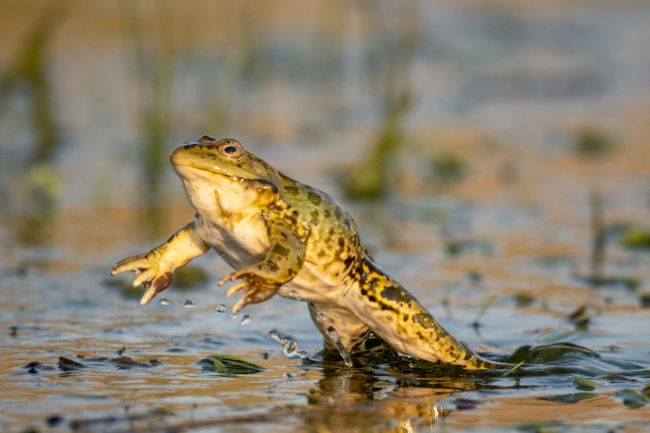
Amazingly many frogs can jump between twenty and thirty times their body length, an impressive feat.
| Behavior | Description | Notable Instances |
|---|---|---|
| Play Dead | Pretending to be deceased to avoid predation | Northern Leopard Frog |
| Burrowing | Burying themselves to avoid predators | Eastern Narrow-Mouthed Toad |
| Jumping | Rapid, evasive leaps to escape threats | Northern Cricket Frog |
| Release of Toxins | Releasing chemicals when attacked | African Bullfrog, Giant Waxy Monkey Frog |
Also read: Distinctions Between Frogs and Toads
Playing Dead (Thanatosis)
Thanatosis is a behaviour whereby an animal pretends to be dead to avoid a predator. It is common in the animal world, with many mammals, amphibians and even insects resorting to this ploy when all else fails.
Pretending to be dead might not seem like such a great idea, but many predators give up being interested when their prey isn’t running away or fighting them. This is in part because eating an animal that has already died might mean picking up the diseases or toxins that led to its death.
Thanatosis isn’t very common in frogs, but there are many species that will practice it in a difficult situation. In this state they will become very still, and seem as though they aren’t breathing. If they’re lucky the predator attacking them will simply wander off.
Also read: Do Frogs Carry Diseases?
Vocalizations
Advertisement Calls
Frogs are well-known for their mating calls, which are often heard during the spring or summer, when males gather together to demonstrate to the females how fit they are. Not all frogs bother with this energy-hungry activity, but these gatherings can be a great way to pull in females for mating.
The volume and rhythm of the call varies greatly between species, but still most of us would recognise a calling frog when we heard one.
Also read: Frog Reproduction and Their Life Cycle
Distress Calls
As well as their mating calls, some frog species can produce distress calls. These are generally loud screams or cries when the frog is under attack. Such utterances can startle the predator just enough to give the frog a chance to get away.
| Frog Call Type | Purpose of Call | Notable Examples |
|---|---|---|
| Distress Call | Signal of potential danger | Wood Frog, Green and Golden Bell Frog |
| Warning Call | Alert to predators or competitors | American Bullfrog, Leopard Frog |
| Mating Call | Attracting mates and establishing territory | Spring Peeper, Pacific Tree Frog |

Regeneration Abilities
Tadpoles and young frogs do sometimes have the ability to regrow their limbs if damaged. This is because they undergo metamorphosis and are able to repair themselves during this process. Unfortunately for adult frogs, they aren’t able to regrow their limbs.
Also read: Limb Regeneration: Can Frogs Regrow Their Legs?
Frequently Asked Questions
- How do frogs protect themselves from predators?
Through camouflage, warning colouration or escaping. - What are some common camouflage techniques used by frogs?
Frogs will use muted colours, variable patterns and natural looking textures to help themselves blend in. - Which frogs are poisonous and how does their toxicity work?
Many frog species are poisonous, though the most famous are the poison dart frogs. They will exude the toxins through their skin via glands. There are many different compounds used in frog toxins, some can cause sickness, while the worst result in death. - Can frogs actually play dead?
Some frog species can play dead. - Why do male frogs make loud calls?
Male frogs make loud calls to attract females, or to scare off predators. - How do frogs regenerate their limbs?
Only tadpoles or young frogs can regenerate their limbs. - Do all frogs have the ability to regenerate?
Adult frogs cannot regenerate their limbs.
Conclusion
Frogs have a surprising array of defense mechanisms, something that has helped them to become so successful in the natural world. They are able to camouflage themselves, produce toxins, jump away and make alarm calls. As outsiders to their lives we can simply marvel at the results as we enjoy the spectacle of colourful frogs, see-through frogs, and well-camoflaged frogs.
Despite all these amazing abilities many frogs are still declining. While frogs are well adapted to defend themselves from their natural predators, they are now faced with new and unforeseen problems, such as the destruction of their habitats. While blending into the background might be fine when surrounded by trees, it’s no use to you once the vegetation has been cleared.
The best thing we can do for these amazing species is to protect what is left of their homes, and nurture back to life those areas that have been lost or damaged. And for those species that have learnt to share our urban spaces, it’s important we give them room, and give them the chance to thrive beside us.
It’s fascinating to think that frogs have chosen such a wide range of ways to keep themselves safe, from those that hide away to those that make themselves stand out. It’s this variety and versatility that makes them so fascinating to observe, and so worth preserving.

